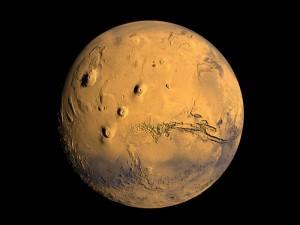
The talk, called ‘Printing Planetary Landscapes and Beyond,’ was presented by former neuroscientist and current Brown University astronomer Seth Horowitz and his research partner Peter Schultz, the director of the Northeast Planetary Data Center (NEPDC). One of the areas that Schultz primarily focuses his research on is the study of impact craters throughout the solar system, not only on the Moon and Mars, but also craters here on Earth. Creating 3D printed physical representations of the impact craters to study was a necessary next step to understanding the geological effects that they have on different planetary bodies.
Schultz is able to conduct his research with mathematical simulations based on information provided by satellite imagery that maps the surface landscape and craters using radar and lidar, a remote sensing process that uses a laser to accurately measure long distances. The same data that allows him to construct his mathematical simulations can also be used to generate 3D models of the surface areas. When the models are 3D printed, they offer him and other researchers invaluable information about the craters that can only be understood by physically holding a 3D representation.
“It’s great to be able to look at a fantastic animation of sunrise over a Martian valley, but being able to pick up a physical model and move it around … all without having to learn another piece of software or needing yet another java update before it works, enhances our understanding of the places,” said Horowitz.
The usage of 3D digital elevation models used to reconstruct the physical landscapes and surface features of the bodies of asteroids, comets, and planets helps researchers to understand their geologic history, determining the sequences of their geologic events, and to understand the structure of impact craters. It is also a useful tool for learning about the geophysics involved with planets and asteroids. Most notably this 3D data has helped NASA learn a great deal about the Gale crater. This includes the crater’s geologic evolution from the time of its formation to a time period when it was completely covered by thick regional deposits and ultimately to its eventual exhumation which left an assortment of sediments that have been anchored by the central peak.
“Having the 3D model amplifies what we’re trained to see with contour maps [and] surface feature maps. The challenge now is to turn this into something more than toys or giveaways. It’s really important to be able to turn this into something usable and I think we’re just at the [edge] of that,” explained Schultz.
Unfortunately not all of the digital elevation data sets are easily converted into 3D printable formats. But Horowitz and Schultz and the Brown University team at NEPDC have been focusing on pulling that data from a wide variety of sources and translating it into formats more suitable for 3D modelling and 3D printing. Thankfully the recent rapid expansion of the 3D printing industry has provided them with several new printing systems, materials and software that are making this daunting task much easier.
And the potential benefits of 3D printing geologic data and impact craters isn’t only going to benefit scientists and geologists, but they make an exceptionally useful educational tool for students. Allowing students to hold a 3D printed representation of the surface of another planet allows them to greater visualize them and understand how these planetary features are formed. And the technology can also be used to help students learn about similar features here on Earth. It’s one thing to see a map or even a 3D animation on a TV or computer screen, but actually holding a model of it offers a completely different experience and can lead to a new level of understanding.
If you want to 3D print your own geologic features from Mars or the moon, thankfully NASA has uploaded hundreds of 3D models that can be downloaded and 3D printed. You can also 3D print many of their space vehicles, probes and satellites, as well as tools, asteroids and even a nebula or two. Check out the entire NASA 3D model library here. Have you printed out these craters? Let us know how they turned out in the Moon and Mars 3D Prints Forum thread on 3DPB.com.